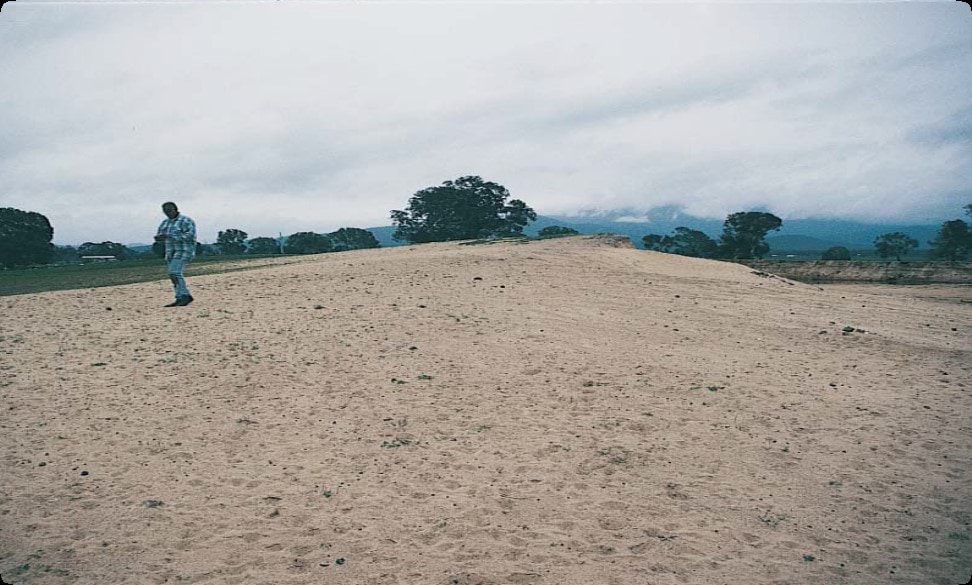Characteristics
- Aboriginal burial places are normally found as concentrations of human bones or teeth, exposed by erosion or earth works
- remains may be scattered over a wide area, but well-preserved remains occur as tight clusters about the size of a human body
- burials tend to be in soft soils and sand, although some burials also occur in rock shelters and caves
- recently exposed bones look ‘fresh’, and may be spotted or stained the colour of surrounding soil. Older remains may be covered by a smooth, cement-like substance and be weathered grey or white in colour
- soil or sand around the bones may be stained with charcoal or ochre
- shell, animal bone and stone tools may sometimes be present
What are Aboriginal burial places?
Aboriginal burial places or graves contain Ancestral Remains - the whole or part of the body of an Aboriginal person from the past. They are normally found as clusters of human bones eroding from the ground or exposed during ground disturbance.
Aboriginal customs for honouring the dead varied greatly across Victoria, but burial was common.
Aboriginal burial places normally contain the remains of one or two people, although cemeteries that contain the remains of hundreds of people buried over thousands of years have been found.
Sometimes the deceased was buried with personal ornaments and artefacts, known as grave goods. Charcoal and ochre are also often found in burial places.
Where are they found?
Aboriginal burial places are found in almost every kind of landscape, from coastal dunes to mountain valleys.
They tend to be near water courses or in dunes surrounding old lake beds.
Many graves have been found on high points, such as dune ridges, within surrounding flat plains.
They are often near or within Aboriginal occupation places such as oven mounds, shell middens or artefact scatters.
How were Aboriginal burial places produced?
Aboriginal people honoured and disposed of their dead in many different ways. The dead were usually buried in the ground, sometimes accompanied by grave goods such as stone tools or personal ornaments.
In some areas, special clothes were made for the deceased. Small fires were often lit inside or near the grave, and sometimes ochre was sprinkled over the body.
In some places, the grave was covered by a special structure such as a small hut or an earth mound, and its location was marked by other earthworks or by cutting bark from surrounding trees.
Other customs included placing the dead person on a wooden platform above the ground, sometimes in a tree, or wrapping the body in bark. After many months, the remains were collected for burial or moved to a cave or rock crevice.
Aboriginal people were buried in the ground in a variety of positions. Some were placed lying flat on their backs, legs fully extended or lying on their side in a crouched, or ‘foetal’ position. Others were buried in an upright sitting position.
They were buried singly or in small numbers. The place of burial was either near the place where they were living at the time, or in cemeteries to which their relatives and descendants returned over hundreds, or even thousands, of years.
Why are Aboriginal burial places important?
The places where the dead are laid to rest have always been important to humans.
Aboriginal burial places have a particular significance for Aboriginal people today and provide important physical and spiritual connections with the land, culture and their past.
Burials provide an important link to the ancestral past, for they are physical evidence of a set of spiritual beliefs that lasted many thousands of years.
Burials also provide us with valuable information about past Aboriginal ways of life, including diet, health, population, economy and social structures.
We can even trace changes in the ways Aboriginal people perceived and related to their environment by looking at the development of large-scale cemeteries.
Threats to Aboriginal burial places
Although human bone can survive for a long time if buried, it deteriorates rapidly once exposed. Wind and water can readily expose and eventually destroy these places.
Because many burials are found in loose soil or sand, they are often disturbed by burrowing animals such as rabbits.
Human activities such as sand mining, stock grazing, ripping rabbit warrens, ploughing and even trail bike riding can devastate grave sites.
First Peoples - State Relations records the location, dimensions, and context of Aboriginal burial places so that we will have a permanent record of this important part of the heritage of all Australians.
Management works, such as the eradication of rabbits, fencing and erosion control, are carried out so that Aboriginal burial locations can be preserved for future generations.
Is it against the law to possess Aboriginal Ancestral Remains?
Yes. It is illegal to possess or display Aboriginal Ancestral Remains without a permit.
If you have such remains contact First Peoples - State Relations so that arrangements can be made for their care.
Are Aboriginal burial places protected?
Yes. All Aboriginal cultural places in Victoria are protected by law. Aboriginal artefacts are also protected. It is against the law to disturb or destroy an Aboriginal place. Artefacts should not be removed from the site.
What to do if you find a burial place
- do not disturb the site or remove any material
- immediately report any discovery of human remains to the Police
- check whether the site has the characteristics of an Aboriginal burial place
- if it does, record its location and write a brief description of its condition
- note whether it is under threat of disturbance.
Please help to preserve Aboriginal cultural places by reporting their presence to First Peoples - State Relations.
Updated


